
Reading Time: 5 minutes
A Time-Tested Strategy Under Scrutiny
Investing in global markets offers a wealth of opportunities, but it also requires a deeper understanding of how these markets behave over time. While much of the focus tends to be on the U.S. stock market, it’s important to consider how international markets have performed as well. A question often asked is whether the impressive long-term returns of U.S. stocks are unique or if similar results can be found globally. The data provides some insightful answers, particularly when we examine the performance of the MSCI World ex-U.S. Index compared to the S&P 500 over various time horizons.
The U.S. Stock Market: A Benchmark for Success
Historically, the U.S. stock market has been a powerhouse. Since 1926, U.S. stocks have delivered positive returns:
| Time Frame | Positive Return Percentage |
| Daily | 56% |
| Monthly | 63% |
| Yearly | 75% |
| 5-Year | 88% |
| 10-Year | 95% |
| 20-Year | 100% |
These numbers are impressive, and they reinforce the idea that time in the market, rather than timing the market, is crucial for success. The U.S. market’s ability to generate positive returns consistently over long periods is why many investors view it as a “safe bet.” However, does this phenomenon extend to international markets?
The Global Perspective: How Do International Stocks Stack Up?
International stock data, specifically from the MSCI World ex-U.S. Index, offers valuable insights into how markets outside the U.S. have performed. While we only have data from 1970 onward, this still provides more than 50 years of market history to analyze. Here’s how the global markets compare to the U.S. in terms of positive returns over different time frames:
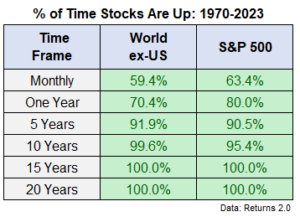
- Rolling Monthly Returns: The S&P 500 has outperformed.
- Rolling 12-Month Returns: Again, the S&P 500 leads.
- Rolling 5-Year Returns: The MSCI World ex-U.S. Index shows a slight edge.
- Rolling 10-Year Returns: International stocks have a higher win percentage.
- Rolling 15 and 20-Year Returns: Both markets perform similarly.
These results highlight that while the U.S. market has outperformed over shorter periods, international markets hold their own—and even surpass the U.S.—over longer time frames.
The Cyclical Nature of Global Markets
One of the key takeaways from analyzing global and U.S. stock returns is that markets are cyclical. There are periods when U.S. stocks lead the way, and other times when international markets take the spotlight. These cycles are evident when we examine rolling 5-year and 10-year returns, where the leadership alternates between U.S. and international stocks.
See this chart below and you can see that there is a cyclical nature of when the U.S. and international stocks outperform, when looking at 5-year monthly rolling returns:
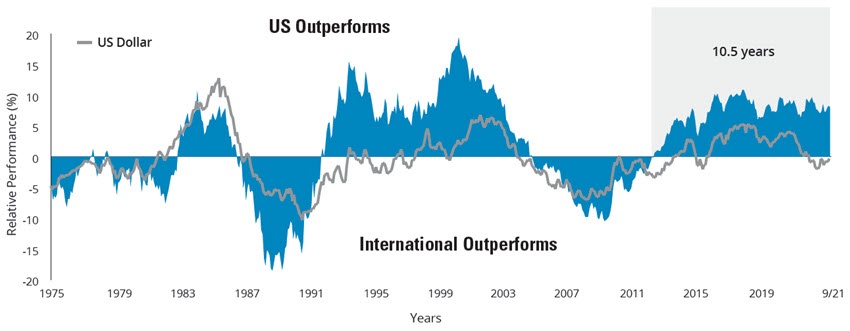
The chart above shows the values of the S&P 500 Index’s returns minus the MSCI World ex USA Index’s returns. When the line is above 0, domestic stocks outperformed international stocks. When the line is below 0, international stocks outperformed domestic stocks.
US equity is represented by the S&P 500 Index; international equity is represented by the MSCI World ex USA Index. Please see below for representative index definitions. For illustrative purposes only.
For instance, there have been times when international stocks, buoyed by strong economic growth in regions like Europe and Asia, outperformed the U.S. market. However, recent history has seen U.S. stocks, driven by tech giants and a robust economy, dominate the global scene. This cyclical nature underscores the importance of diversification in an investment portfolio.
The Cyclical Case for International Exposure: Higher Expected Returns
Over the past decade, a broadly diversified U.S. stock portfolio would have returned almost twice as much as a comparable international portfolio for a U.S.-based investor. This disparity in performance may lead some investors to question their allocation to non-U.S. stocks. However, there is reason to believe that the next decade could look very different.
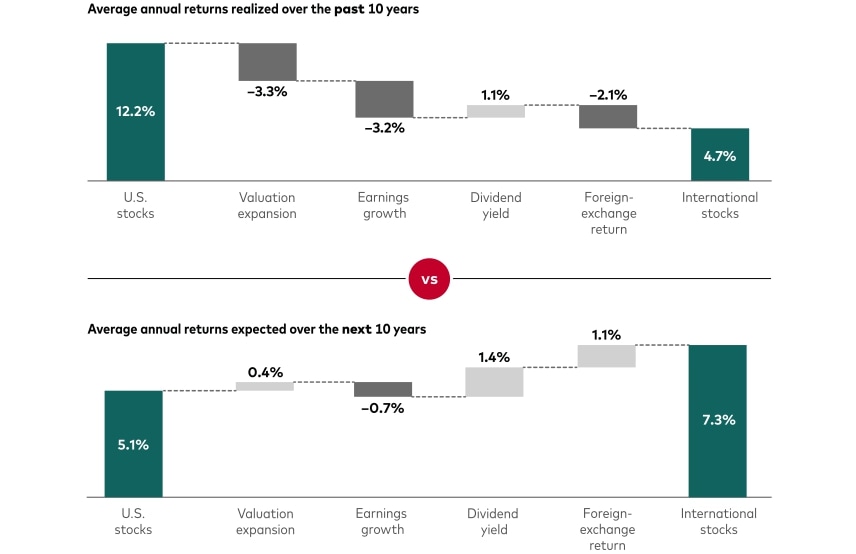
From April 1, 2013, through March 31, 2023, U.S. stocks outperformed their international peers by an average of 7.5 percentage points annually. This outperformance was primarily driven by rising stock valuations and higher earnings in the U.S., which contributed 3.3 and 3.2 percentage points, respectively. Valuations expanded faster in the U.S. due to higher growth expectations for the American economy and earnings. Additionally, the U.S. dollar’s strength over the past decade subtracted 2.1 percentage points from international returns, overshadowing the 1.1 percentage points of outperformance from higher dividend yields in international markets.
Looking ahead, the situation may reverse. Projections suggest that international stocks could outperform U.S. stocks by an average of 2.2 percentage points annually from March 2023 through March 2033. This expectation is based on median projections of 5.1% annual returns for U.S. stocks and 7.3% for international stocks. This potential shift underscores the cyclical nature of markets and the importance of maintaining a diversified portfolio.
Surprising Facts About International Markets
One of the most surprising findings is that international stocks actually have a higher winning percentage than U.S. stocks over 5-year and 10-year periods. This runs counter to the common perception that the U.S. market is always the best performer. The magnitude of returns, however, often overshadows these winning percentages. While the U.S. market has indeed delivered substantial gains, the consistent positive performance of international markets is a reminder that long-term investing works globally, not just in the United States.
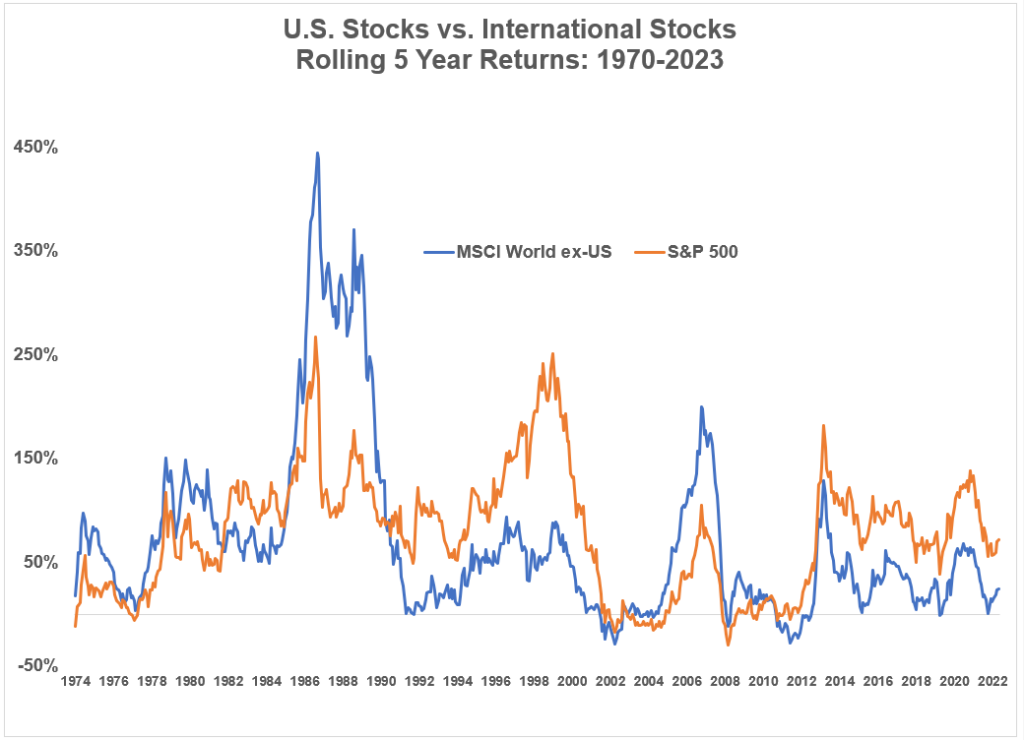
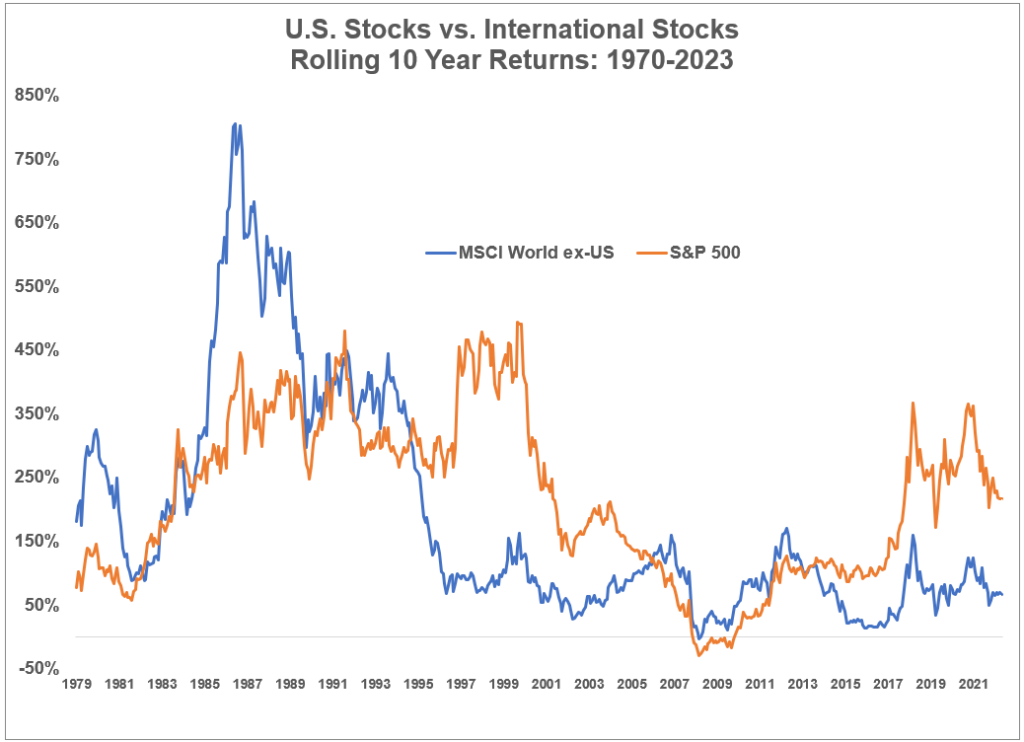
The Importance of Patience and Diversification
Whether you’re investing in the U.S. or international markets, patience remains the ultimate equalizer. The data shows that the longer you stay invested, the higher your chances of achieving positive returns. This principle applies globally, reinforcing the value of a diversified portfolio that spans different geographies. By investing across various markets, you mitigate the risk associated with any single country’s economic downturn, while still capturing growth opportunities worldwide.
“The stock market is a device to transfer money from the ‘impatient’ to the ‘patient’.” ~Warren Buffett
Long-Term Investing Knows No Borders
The data speaks for itself: long-term investing is not a U.S.-only phenomenon. While the U.S. stock market has a storied history of success, international markets offer compelling opportunities as well. With a commitment to patience and diversification, investors can achieve positive returns whether they focus on domestic or global markets. In a world that’s increasingly interconnected, looking beyond borders is not just advisable—it’s essential for a well-rounded investment strategy.
To take the next step in understanding your portfolio’s performance and determining your risk number, we invite you to reach out for a complimentary call or coffee. We are here to assess your current portfolio and guide you through aligning it with your long-term goals. Start by visiting investedwithyou.com and clicking on the “Get Started” button. We look forward to helping you achieve greater financial confidence.
Schedule a short discovery call or meeting



